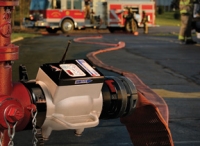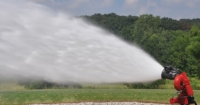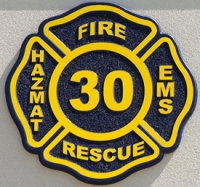 |
| Elkhart Brass debuted the Scorpion EXM monitor, a high-flow, high-tech unit capable of flowing up to 3,000 gpm. |
 |
| Elkhart Brass, now the owner of Hero Pipe, has converted the high-rise monitor system to use EXM remote capabilities, including digital and infrared cameras. |
 |
| TFT introduced the Hydrant Master, what it calls the world’s first remote-controlled hydrant valve. |
 |
| TFT’s Oasis Hydrant Assist Valve allows improved water supply in a number of situations. |
 |
| Akron Brass debuted the 3462 Forestry monitor for brush and wildland firefighting, available in flows up to 300 gpm. |
 |
| Akron Brass’s GP Manual monitor is rated to flow up to 1,000 gpm with a 360-degree rotation. |
Manufacturers have introduced an array of new valves, monitors, nozzles, and other fire suppression equipment. In many cases, these devices incorporate technology, making them “smarter” than their predecessors.
Elkhart Brass recently debuted its new Scorpion EXM monitor, the second Elkhart monitor (after the Sidewinder) to incorporate the EXM operating system.
The Scorpion EXM is a high-tech, high-flow unit—up to 3,000 gpm—that uses a patented variable cross-section vaned waterway, axially-aligned thrust bearings, and extreme torque motors and provides a superior range of vertical and horizontal motion, according to Don Sjolin, chief operating officer.
The unit supports wireless and wired communications by panel-mount or handheld controller, joystick, or OEM-sourced controller or switches, Sjolin points out. Scorpion EXM’s electric motors are also sealed to NEMA 6 for full submersion.
Elkhart’s EXM operating system allows water flow information to be shared and integrated with the vehicle’s information system. Sjolin says EXM is in use in fire apparatus, AARF, military, and deicing vehicles.
Elkhart has also introduced its SM500E Automatic Nozzle, which performs well in flow-rate applications produced by the Sidewinder EXM. The new nozzle flows between 350 and 1,000 gpm and can maintain pressure with 10 psi, plus or minus. It’s available in both low- pressure (75 psi) and high-pressure (100 psi) versions.
The High-Rise Elbow is a lightweight, compact unit with an integrated Model 114 drain valve to help relieve pressure on traditional high-rise setups. It features a 30-degree elbow to eliminate kinking and has a standard NH thread and knurled edge coupling for tight Class 1 or Class 3 hose cabinets.
Elkhart has also announced that it acquired Hero Pipe and appointed Hero Pipe founder Michael Wielgat as director of Hero Systems.
Sjolin says Elkhart converted the Hero Pipe to function on the EXM system to improve its capabilities. He also notes that Elkhart has received a letter of intent from the Fire Department of New York (FDNY) to purchase between six and 12 Hero Pipes.
Wielgat says the Hero Pipe can sweep 40 degrees left and right, as well as 80 degrees up and down. It can be rigged with a thermal imaging or digital camera (or both), he notes, and has the ability to determine the situation in a chemical, biological, radiation, or nuclear (CBRN) incident.
Hero Pipe can function for up to 1.5 hours of unmanned operation on its battery. Two Hero Pipes can be installed and operated on a single standpipe, Wielgat adds.
Task Force Tips’ (TFT) latest innovation is what it calls the world’s first remote-controlled hydrant valve—the Hydrant Master.
A firefighter places the Hydrant Master on the hydrant’s steamer connection and opens the hydrant, allowing water to the valve but not charging the hose. Hydrant Master transmits both static and residual hydrant pressure to a handheld remote at the pumper that shows the valve condition as open or closed.
The Hydrant Master is battery-operated (four AA batteries) and allows for opening and closing a hydrant valve slowly to react to differing hydrant pressures in different cities. The unit senses the pressure and opens slower on a higher-psi hydrant than on a lower one, preventing a large slug of water from ripping down the supply line to the pumper.
TFT’s research has shown it takes between 15 and 18 seconds for the typical firefighter to open a hydrant.
“With departments struggling with staffing, it’s important to get firefighters back on the apparatus and to the scene to begin fireground operations,” says Ron Prast, Midwest regional manager. “It’s not productive to have a firefighter at a hydrant, waiting for the signal to flow the water.”
TFT also offers its Oasis Hydrant Assist Valve that allows improved water supply from poorly performing hydrants, long rural water delivery relays, or small-diameter hose operations.
Prast says the hydrant valve, which can have three five-inch Storz connections, can be used as a hydrant booster, as a gated wye, or for inline pumping during relay operations. The valve is designed for use with 3½-, 4-, 4½-, and 5-inch hose and uses stainless steel half-ball valves for corrosion protection.
In addition, TFT offers its Blitzfire Portable Monitor, a unit with a flow rating up to 500 gpm and a safety shutoff system that prevents unintentional movement during fireground operations; a high-volume, low-level strainer with an optional jet siphon that provides flows up to 2,000 gpm with less than 1 psi friction loss; its MidForce dual-pressure automatic nozzle that flows from 70 to 200 gpm; and its Valve Under Monitor, a lightweight, low-friction-loss valve and manifold intended to be installed directly beneath monitors on ladders and platforms.
Akron Brass Co.’s new GP Manual monitor is what Jeffrey Benson, global product line manager, calls “one of the most cost-effective, highest-performing firefighting monitors in the world.”
The GP Manual monitor is rated to flow up to 1,000 gpm, has a continuous 360-degree rotation, elevates from +90 degrees and depresses to –45 degrees, has a built-in pressure gauge, and offers a T-handle for positioning and control.
The unit is available with a variety of nozzle options, from smooth bore tips to adjustable-flow triple-stacked tips. It also is available in foam tube and foam nozzle options.
Another new monitor from Akron is the Forestry electric monitor, available in 30- to 125-gpm and 125- to 300-gpm versions.
“The 3462 Forestry monitor is ideal for brush and wildland firefighting,” Benson says. “It’s compact, has a fully-sealed integrated electrical control system, waterproof locking connectors for all motors and power connections, and high-speed motors.”
Akron also introduced its new Universal Control II (U-II), developed for OEM or service use in networking water flow appliances into a fire apparatus system. The plug-and-play system has a tool to diagnose and modify software if necessary and is available on all Akron electric monitors.
POK of North America has introduced its new Hydrant Snorkel—a hydrant valve that allows a water supply to be established on hydrants that are seemingly inaccessible because of deep snow or other blockages.
The Hydrant Snorkel’s inlet elbows, extension tubes, and outlet elbows are made of aluminum alloy and are available in 4-inch Storz, 2½-inch Storz, and 2½-inch NST. The valve is supplied with an extended hydrant wrench.
The company debuted its Slide-O-Matic nozzle that operates at 150 gpm at 100 psi but can be switched to 55 psi and get the same gallonage without shutting down the nozzle. The change is controlled by the nozzle ring, which has large knobs to allow a firefighter to feel the pressure and flow type changes.
ALAN M. PETRILLO is a Tucson, Arizona-based freelance writer who writes for national and regional magazines and newspapers. He served 22 years with the Verdoy (NY) Fire Department, including in the position of chief.
More Fire Apparatus Current Issue Articles
More Fire Apparatus Archives Issue Articles

